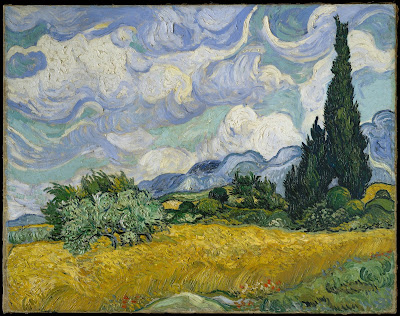Impressionism and Post
Impressionism are major moments in the art history. In 1874, group of artists began to oppose academic
doctrines and Romantic ideals and turn to paint representation of everyday
life. This period is called impressionism. Impressionist painters took their
canvases outdoor and tried to paint what their eyes catch rather than what
minds know or interprets of a scene. They
made their paintings the way traditional painters would have made sketches of
paintings; by painting quickly as possible. It’s called immediate perception
technique. Landscapes and scenes from everyday life in different conditions are
the main subjects of these paintings. This period is named after Claude Monet’s
panting; impression, sunrise. Impressionist painters painted their paintings
without personal or religious interprets. One can see naturalistic depiction of
light and color, visible separate stroke and dabs of paints, and applied pure
diverse colors placed next to each other among impressionism paintings.
Post Impressionism period starts in
about 1885 following the impressionism period. Post-impressionist artists
believed in free interpretation of nature and, oppose the acts of
impressionist’s artists. Post impressionism artist went in two different ways. Some
went for clear formal organization and other toward personal expression. Post
impressionism artists used strong lines in colors, flat color areas, unnatural
hues, flattening out depth of space and strange composition in their paintings.
This painting is called Garden at
Sainte-Adresse. It painted by Claude Monet in 1867 using oil on canvas. The
subject of this painting is the view of the garden terrace at Sainte-Adresse, a
seaside resort, over the sea. This painting is structured in three horizontal
bands which are the garden terrace, the sea, and the sky. The gray beard person
seated in the foreground is his father and other models consider as his
relatives. This painting has a look of a sketchy. Shapes and forms don’t have
sharp details. One can see separate strokes and unmixed paints all over the
painting. He used different shades of blue to paint sky and sea. Pale blue
colors and white in the sky give its natural atmospheric look. He used dark
shades of blue paint moving waves in the sea. Monet used hot colors, bright red
and yellow hues, on the foreground to make sense of contrast. He executed his
techniques successfully to show sunlit and shadowy areas. The vanishing point
of this painting is placed in the center of the horizon.
This post-impressionist painting is called Wheat Field with Cypresses. This 28 7/8 × 36 3/4 in size oil on canvas painting was done by Vincent Van Gogh in 1889. This is a portrayal of his perception and intensity feeling of nature. He used strong color lines all over the painting which gives a sense of motion. The tall dark green cypress tree provides a powerful contrast to the horizontal wheat field and sky. The oppositions of warm and cool colors provide the depth of space. The depth of space is flattening out in this post-impressionist painting. Warm foreground indicates that it’s painted during a bright summer day. One can see yellow hues among curvy clouds in the blue sky.





